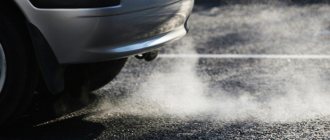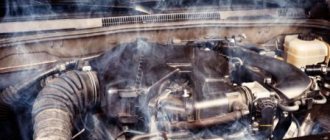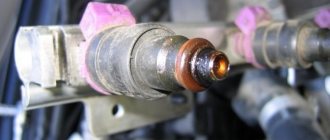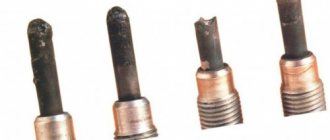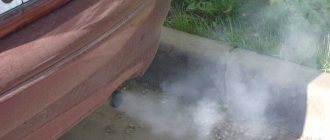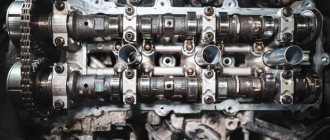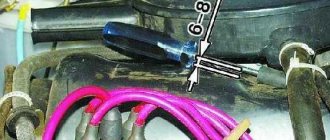When starting the engine when cold, thick smoke often appears coming out of the exhaust system. Smoke can have different shades from white to blue and even black. The smoking stops after the engine warms up, and may continue afterwards.
If a warm engine smokes, this means that the power unit has specific malfunctions. The color of the exhaust gases indicates the stage of development of the breakdown and its severity.
Brief description of the symptoms accompanying the release of smoke
In some cases, smoke may be accompanied by the following symptoms:
- difficulty starting a cold engine;
- unstable operation of the engine both at idle and under load;
- inconsistency of tachometer readings (speeds fluctuate);
- increased fuel and engine oil consumption;
- loss of power of the power unit.
There are often situations in which engine smoking is the only warning sign.
The design of the vehicle is designed for the system to constantly, unnoticeably release exhaust gases into the atmosphere in specified volumes. But if, when starting the engine, smoke comes out of the exhaust pipe in large quantities, it is necessary to urgently look for the cause of the alarming symptom that has appeared.
The first thing you need to pay attention to is the color, shades and density of the smoke coming from the engine. The most common colors of the gases released are:
Each of the listed smoke colors can have different shades, but this division into groups is the main one.
What do car owners think about smoke from the engine after an oil change?
1. Does the engine smoke after changing the oil? It could be a problem with flushing.
– I think that everything is not so sad. From personal experience: when changing the lubricant, I flush the engine for five minutes. Although I usually fill it with long-lasting oil, every 200 kilometers. After changing the oil, the engine usually starts to smoke slightly. After a few days everything returns to normal. I'm guessing it's the residue from washing that burns off. Once I had the grease replaced in a Merc. The driver yelled that they had poured low-quality oil and that was why the car was smoking. But the lubricant was from a NESTI barrel. I know these guys, they won’t spread any nasty stuff. So I'm right.
2. Reasons for the increase in lubricant waste in the engine.
There are a couple of main points that increase the fuss:
- The oil is of low quality or incorrectly selected . You should only pour the lubricant into the engine that is recommended by the car manufacturer. You need to purchase it in trusted stores, take only oil from well-known manufacturers.
- Excessive operation of the engine . As a rule, the engine is operated at high speeds. In such cases, the temperature of the mechanism increases and much more oil is required to lubricate and cool the engine. Remember: at low temperatures, lubricant consumption increases. This happens due to the special operating conditions of crankcase ventilation. To reduce waste, warm up the car at idle speed in cold weather.
By applying these simple tips, you can reduce oil waste and increase the service life of your engine.
Certain engines consume a lot of lubricant due to design features. For example, the N52 engine from BMW, which is installed on many cars of this German automaker.
The lubricant level decreases for the following reasons: waste and leakage. So, with the right choice of lubricant and careful driving, a good engine will not consume a lot of oil. However, if the conditions are the same, and the lubrication level is reduced, then the source of the breakdown should be found.
3. What causes engine oil to burn out?
The inspection did not reveal any significant leaks of lubricating fluid. The lubricant may be burning out. You can often see this for yourself.
Usually, when the lubricant burns out, the smoke from the exhaust pipe has a bluish tint and a dense structure, that is, it does not look as usual. An experienced driver will immediately pay attention to this. In this case, oil burnout only sometimes occurs due to a serious malfunction in the engine.
In most cases, this happens due to several reasons. Cylinder wear (the first reason) is usually possible on older cars with significant mileage. As a result, lubricant consumption increases.
It is not possible to find out the cause of cylinder wear. Sometimes poor quality lubrication or simple contamination is to blame.
Whitish smoke with a bluish tint from the exhaust indicates that the lubricant is burning out. This process causes increased oil consumption in the engine.
The way out of this situation is quite simple: change the oil. You need to purchase high-quality lubricating fluid specifically designed for your machine.
Otherwise, you need to flush the engine. This way you can remove accumulated dirt and carbon deposits.
Causes of engine smoking
Why does the engine smoke? Car owners are often interested in this. The main malfunctions that cause increased smoke output from the exhaust pipe:
- damage occurring in the fuel supply system;
- wear of parts included in the cylinder-piston group;
- disturbances in the operation of the gas distribution mechanism;
- problems with the cooling system.
Smoke may appear when the quantitative air-fuel balance is disturbed, uneven mixing and incomplete combustion of the air-fuel mixture, or failures that occur when coolants or lubricants penetrate the combustion chambers.
Each of the reasons described can affect the shade of the smoke cloud emitted.
An experienced technician is able to take into account the impact of defects in one system on the incorrect operation of other components of the power unit. For example, problems that occur in the cooling system lead to overheating of engine components. Under the influence of ultra-high temperatures, the piston rings are destroyed, the seal is broken, oil and coolant penetrate the cylinders, burn, producing smoke of a certain color.
After capitalization, as a rule, the engine smoke stops.
Why does the engine smoke black smoke?
Why does a diesel engine smoke black? This sign indicates that the engine is operating on an over-enriched fuel mixture. Moreover, the shade of smoke can be both dark gray and deep black. The culprit is soot formed due to inefficient combustion of fuel. Most likely, the breakdown occurred in the fuel supply system.
In addition to black smoke, there are a number of other signals indicating this malfunction:
- the engine is difficult to start;
- increased fuel consumption;
- power decreases;
- catalysts burn out and the like.
Why does an engine with carburetor injection smoke at idle? This happens due to overflow in the float chamber. To fix the problem, you will need to clean the jets on the carburetor. It is through them that air is supplied. It is also recommended to inspect the needle valve.
If the engine is fuel-injected, it may produce black smoke when the electronic sensors stop functioning properly. Depressurization of the injection nozzles may also occur. As soon as the injectors begin to overflow, an excess of the fuel mixture is observed and enters the combustion chamber. Excess fuel takes some of the lubricant from the cylinder walls and enters the crankcase.
How can you tell if fuel has gotten into the oil? In this case, you will notice a strong gasoline smell. Sometimes the oil level in the engine rises because gasoline gets into it.
Why does a diesel engine still smoke black smoke? This often happens due to low-quality fuel.
The following breakdowns may also occur:
- injectors are worn out;
- the air filter is dirty;
- The speed controller in the fuel injection pump is broken;
- the high pressure fuel pump is faulty;
- the turbine failed.
The high-pressure fuel pump is considered the most complex element of the fuel supply system installed on diesel engines. In order for this unit to function properly, lubrication in the diesel engine is required. If the fuel is of poor quality, the fuel pump will fail ahead of schedule.
We recommend
“How to store tires: summer tires in winter, and winter tires in summer” Read more
Clear smoke from the exhaust pipe
The steam coming out of the engine can be mistaken for white smoke. Steam is formed during the evaporation of accumulated liquid in cooled engine systems. Most often, the accumulation of liquid at the end of the exhaust pipe and the release of steam are observed in the cold season after starting the engine.
The engine and exhaust system components heat up and water evaporates rapidly. After the engine and exhaust system have completely warmed up, the amount of steam is reduced to a minimum or disappears completely.
The amount of steam released depends on the humidity levels in the environment; the higher they are, the longer its traces will be visible. The release of steam is not a sign of breakdown of engine parts and components; if this effect occurs, repairs are not required.
Problem options
VAZ cars have many different problems, including frequent exhaust system and engine malfunctions. Most malfunctions of the ignition system, exhaust and engine components are accompanied by smoke. This happens for a variety of reasons. First you need to look at all the options when you don’t need to worry about the integrity of any of the systems.
Here is the first and main one: the engine starts, abundant white smoke begins to emit from the exhaust pipe.
This is quite normal.
trong>The white color of the vaporous substance indicates that the car’s mechanisms began to work with a large temperature difference between the cold parts and the environment. This usually happens after a long period of inactivity. When the engine starts, all internal systems immediately heat up, and steam, which is usually not visible, is released in huge quantities due to the sudden change in temperature. Many beginners may be intimidated by the large cloud that forms from the exhaust after starting the engine.
But this does not bode well if no increase in fuel, oil or cooling fluid consumption has been noticed. Particularly thick vapor formation occurs after cold winters and long periods of machine downtime without operation.
White vapor is not dangerous, so there is no cause for concern.
Black smoke coming out
The greatest damage to the environment is caused by clouds of black smoke coming out of a car's exhaust pipe or directly from the power unit. The most likely reasons for the appearance of such smoke lie in the following violations:
- malfunctions of the engine control system;
- disorder of adjustments in fuel equipment;
- reducing engine cylinder compression.
An imbalance between the number of components of the air-fuel mixture in the direction of increasing fuel causes not only the formation of black smoke, but also significantly increases fuel consumption. Failure of the normal mixture formation process may be caused by contamination of the air filter. A deficiency of air entails an excess of fuel when preparing the air-fuel mixture.
A decrease in the compression level can be caused by mechanical damage to the cylinders, which significantly reduces the power of the power unit and contributes to an increase in the concentration of fuel in the mixture.
To carry out accelerated diagnostics, it is necessary to examine the condition of the spark plugs. Black deposits indicate that there is a need to replace spark plugs with new samples, followed by repair of deformed elements and regulation of power unit systems.
Diesel smokes black smoke
The presence of a black cloud emanating from a diesel engine may indicate incomplete combustion of the fuel mixture, due to which the rest of it burns in the exhaust pipe. There can be many reasons for the appearance of black smoke, but the most common include the occurrence of oil scraper rings, carbon deposits, problems with the operation of the fuel pump, overload of the power unit, contamination of the fuel injectors or filter. Let's consider each of the causal factors separately.
Black smoke from the exhaust pipe
Occurrence of oil scraper rings
In this case, fuel consumption increases along with black smoke. If the rings are stuck, they must be replaced. Also, the car owner will face a more expensive procedure - replacing the cylinders.
Occurrence of oil scraper rings
The appearance of soot
The settling of carbon deposits in the combustion chamber is accompanied by the appearance of black or gray smoke even under light loads on the engine. Carbon deposits may appear on or around the valves. In addition to black smoke, characteristic signs of carbon deposits include increased consumption. The resulting carbon deposits can be eliminated using special additives.
Carbon deposits in the combustion chamber
Fuel pump malfunction
An incorrectly adjusted fuel pump can also cause diesel smoke. This is due to an increase in the amount of fuel supplied to the injectors. There is not enough air in the combustion chamber, so excess fuel enters the exhaust system and burns out there.
Diesel fuel pump malfunction
Motor overload
Overload often occurs when the car is moving uphill with a high gear engaged. To relieve the load on the engine, it is recommended to engage in lower gears. This will prevent the appearance of black smoke from the exhaust pipe and ensure reliable operation of the vehicle.
Diesel smokes under load
Clogged injectors
During the operation of the vehicle, carbon particles may accumulate on the walls of the injectors, which disrupt the fuel supply process, which ultimately does not burn completely. To eliminate the problem and extend the life of the injectors, they need to be cleaned. Although in some cases only replacing the injectors can help.
Diesel injector contamination
Filter dirty
When the air filter is clogged, the amount of air in the fuel mixture decreases, which leads to incomplete combustion of the fuel. You can eliminate smoke by cleaning the filter element or replacing it.
Air filter clogged
White smoke appears
An engine that smokes white gas does not always release harmless water vapor. White smoke is distinguished from steam by the following characteristics:
- increased smoke density;
- long-term dispersion;
- presence of a persistent burning odor;
- does not disappear when the engine warms up.
White thick smoke coming from the exhaust pipe of a car indicates a malfunction in the cooling system. The variety of shades of white smoke depends on the type of coolant used, but in any case, with such emissions, it is necessary to carry out urgent repairs to the engine cooling system.
Incorrect operation of the cooling system elements can lead to serious disruptions in the functioning of the power unit as a whole.
Causes of white smoke:
- cracks in the cylinder head (cylinder head);
- coolant entering the engine cylinder cavity;
- motor overheating;
- use of low quality coolant.
The engine smokes white smoke
White smoke during warm-up mode is often just steam that condenses in the exhaust system. Steam will be visible until the exhaust heats up. You can also see drops of water at the end of the pipe. If the outside temperature is low, then steam will be visible even after the engine warms up and reaches operating temperature. The density of such smoke is additionally influenced by air humidity. If the humidity is high, then there will be more smoke.
The appearance of a thick cloud of white smoke in the warm season after the internal combustion engine has warmed up often indicates that it is getting into the cylinders. A common cause of sudden white steam smoking is previous engine overheating. Water is a component that is present in the coolant. It turns out that some of the water does not have time to evaporate in the combustion chamber. Coolant ingress can occur as a result of destruction of the cylinder head gasket or cracks in the passage of the cooling jacket channels through which the coolant moves.
We also recommend reading the article on how to weld a crack in the block and cylinder head. From this article you will learn about ways to remove such defects.
White smoke is a vapor that easily dissipates into the air. To check, you can attach a sheet of clean paper to the exhaust pipe. The water will gradually dry on the sheet without leaving any distinct greasy marks.
The next step in diagnosis is to check the cooling system for exhaust gases. To do this, simply unscrew the radiator cap or expansion tank cap with the engine off. If you smell the exhaust, there is a film of oil in the fluid itself and the fluid level is low, then the malfunction is obvious. Starting the engine in this case will lead to a significant increase in pressure and an increase in the coolant level in the tank. You can also observe gas bubbles and even seething in the tank.
Subsequent stopping of the engine will cause the level to drop and the coolant will partially flow into the cylinder. From the cylinder, the liquid seeps through the piston rings and ends up in the oil pan, mixing with the lubricant and diluting the engine oil. It turns out a kind of emulsion, the color of the oil changes and the lubricant becomes cloudy.
The entry of coolant into the lubrication system is diagnosed by analyzing the cylinder head cover and the oil filler plug. A light foam appears on the inside of the lid, which has a yellowish tint. The presence of emulsion in the oil can also be seen on the oil dipstick.
A large amount of coolant in the lubrication system will indicate a serious crack or burnout. In some cases, liquid may accumulate in the space above the piston, making it difficult to start the engine. It is worth adding separately that in such a situation there is also a high risk of water hammer. With minor coolant leaks, an emulsion may be present on the cap, but other signs will not be immediately noticeable.
Fault diagnosis
You can more accurately determine the problem cylinder in the following ways:
- Unscrew the spark plugs and check their condition. Coolant tends to “wash out” the spark plug in a faulty cylinder.
- Align the crankshaft so that the intake and exhaust valves are closed. Next, you need to apply compressed air through the spark plug hole, and then look into the expansion tank. An increase in coolant level as a result of air supply will directly indicate a faulty cylinder.
- Remove the cylinder head to check the gasket and adjacent surface of the head. If no defects are identified, then the head is checked for tightness under pressure;
- Perform cylinder diagnostics. To do this, the piston must be lowered to BDC and the walls checked for cracks;
- Check the intake manifold gasket. This is done if, in a particular internal combustion engine, such a gasket structurally serves to seal the coolant circulation channels.
What to do if you detect dense white smoke
When disassembling the cylinders, it is necessary to analyze the condition of the spark plugs. The formation of scale on the candles indicates that water has gotten inside. After examining all cylinders and glow plugs located in them, it is necessary to repair or replace the cylinders and glow plugs. It is recommended that these measures be carried out with the help of qualified technicians at the nearest service station.
Often, low-quality coolants, when in contact with the working elements of the engine, cause increased corrosion of components and parts of the power unit. Cheap varieties of antifreeze can literally corrode the internal parts of the engine when leaks occur. After such an impact, it is not possible to repair damaged parts.
To ensure that the coolant penetrates into the combustion chamber, it is necessary to remove the cap from the expansion tank. A sharp burning smell, a decrease in the level of antifreeze in the tank, and a floating oil film indicate the detection of this defect.
Smoke with a bluish (gray) tint
If a diesel or gasoline engine smokes heavily with blue gas, this means that engine oil is leaking into one or more cylinders. During combustion, thick clouds of smoke are formed, which have a persistent smell of burnt oil and do not dissipate for a long time.
Depending on the type of motor oil used and the ambient temperature conditions, the color of the smoke may have different intensities of blue. To give a more accurate assessment of the nature of the smoke coming out and distinguish it from standard exhaust, it is necessary to regularly check the oil level. Excessive consumption of machine lubricant indicates the presence of leaks.
In addition to visual analysis of the color of the exhaust gases, a check is carried out using paper attached to the exhaust pipe. If distinct spots of an oily nature remain on the sheet, then the reason for the release of bluish smoke with a bluish tint from the chimney becomes clear: the presence of oil in the combustion chamber.
What smokes from the VAZ 2110 muffler?
Blue smoke from the exhaust pipe
The main reason why blue smoke appears from the exhaust is oil getting into the engine cylinders. “Oil” smoke can have different shades - from transparent blue to thick white-blue, which depends on the operating mode of the engine, the degree of its warming up, the amount of oil entering the cylinders, as well as lighting and other factors. It is characteristic that “oil” smoke, unlike steam, does not dissipate quickly in the air, and as a result of the test with paper mentioned in the previous article, oily drops appear, flying out of the pipe along with the exhaust gases.
It is also obvious that “oil” smoke is accompanied by increased oil consumption. Thus, at a consumption of about 0.5 l/100 km, bluish smoke appears mainly in transition modes, and upon reaching 1 l/100 km - also in uniform motion modes. By the way, in the latter case, during transient conditions, the “oil” smoke becomes thick blue-white. However, owners of the most modern cars need to remember about the possible presence of a converter that can clean the exhaust gases from oil even at a fairly high flow rate.
Oil enters the cylinders (more precisely, into the combustion chambers) in two ways - either from below, through the piston rings, or from above, through the gaps between the valve stems and guide bushings.
Wear of parts of the cylinder-piston group is one of the most common causes of “oil” smoke. the upper compression rings experience wear not only along the outer surface in contact with the cylinder, but also along the end planes experiencing gas pressure in the cylinder. The grooves of these rings in the pistons may also be worn out. Large gaps in the grooves create a pumping effect. Even if the oil scraper rings are still normal, oil still enters the cylinders, since the upper rings continuously “pump” it from the bottom up.
Cylinders wear out most of all in the stopping zone of the upper ring when the piston reaches top dead center, and in the middle part they often acquire an oval shape. Deviation of the cylinder shape from the circle impairs the sealing properties of the rings. Gaps usually form in the area of locks, but it is possible that they may appear in other places. therefore, measurements of the cylinder diameter during defect detection are carried out in at least two vertical planes and three to four levels horizontally in order to more accurately determine ovality and ellipse.
It is not uncommon for the cylinder surface to be damaged when the rings and pistons are in relatively normal condition. This happens when the oil filtration is poor, if abrasive particles get between the piston skirt and the cylinder. In the same case, scratches occur on the cylinder.
The same effect often occurs when engine repair technology is violated, if the surface of the repaired cylinder is too rough, or the cylinder is of the wrong shape, or low-quality pistons and piston rings are used. in such cases, as a rule, one cannot count on normal grinding in at all.
Wear of parts of the cylinder-piston group is often accompanied by loss of compression and an increase in crankcase gas pressure, which is determined by appropriate instruments (compressometer, leak tester, etc.). however, it should be remembered that a large amount of oil entering the cylinders well seals the gaps in the mating parts. if they are not too large, then the compression measurement result can be quite normal, sometimes even closer to the upper limit. It is this circumstance that confuses the search for a specific cause of blue “oil” smoke.
By the way, when there is no significant wear on parts, blue or blue-white smoke is clearly visible only when the engine warms up, gradually decreasing and even disappearing. the reason is simple: when heated, the parts take on a shape and take up space in which they fit better together. with excessive wear, the picture is the opposite: smoke on a warm engine will increase, since it is easier for hot oil, which has a low viscosity, to enter the cylinder through worn parts.
It is always easier to identify a malfunction associated with more serious defects or even broken parts. Thus, detonation usually leads to breakage of the bridges between the rings on the pistons, and less often to breakage of the rings themselves. Severe overheating of the engine causes deformation of the piston skirts, creating a large gap between the piston and the cylinder. a deformed piston warps, disrupting the operation of the rings. the same result can occur when the connecting rod is deformed, for example, due to engine hydraulic shock when water enters the cylinder or after a belt breaks and the piston hits a valve that has not closed.
The use of low-quality oil can cause the rings to burn and stick in the piston grooves. and due to prolonged glow ignition, the rings can simply be rolled into the grooves with a complete loss of mobility.
The defects discussed above usually do not occur in all cylinders at once. It is not difficult to find a faulty cylinder by comparing the condition of the spark plugs and the compression value in different cylinders. Moreover, such defects are often accompanied by various kinds of extraneous noise and knocking, which change with speed, load and degree of engine warm-up, as well as unstable engine operation due to cylinder deactivation (especially during a cold start).
A common group of faults that cause “oil” smoke and excessive oil consumption is associated with wear of valve stems and guide bushings, as well as wear, mechanical defects and aging (loss of elasticity) of valve stem seals. These defects, as a rule, give a noticeable increase in engine smoke as it warms up, since the liquefied hot oil passes much more easily through the gaps between worn parts.
In addition, oil penetration into the cylinders increases at idle and during engine braking. in these modes, a large vacuum occurs in the intake manifold, and oil flows along the valve stems under the influence of a pressure difference, accumulating on the walls of parts and in the exhaust system. the subsequent opening of the throttle valve at the first moment sharply increases the density of the blue “oily” smoke.
For turbocharged engines, oil consumption accompanied by blue smoke is possible due to a malfunction of the turbocharger, in particular wear of the bearings and rotor seals. wear of the compressor front bearing seal gives a picture similar to the failure of the valve stem seals (including oil deposits on the spark plugs), but at the same time a puddle of oil collects in the compressor inlet pipe. A turbine seal malfunction is difficult to identify, since the oil enters directly into the exhaust system and burns out there.
In operation, blue smoke and excessive oil consumption often occur when one of the cylinders is turned off due to an ignition fault or when the valves are not sealed. in the latter case, the smoke becomes white-blue, especially if the valve has an obvious burnout. such a defect is easily determined - the compression in this cylinder is insignificant or completely absent, and abundant black soot appears on the spark plug, often in the form of growths.
There are also quite exotic defects that cause blue “oil” smoke. Thus, in automatic transmissions with a vacuum load sensor, the regulator membrane may rupture. since its cavity is connected by a hose to the intake manifold, the engine simply begins to suck oil from the gearbox.
As a rule, oil enters only those cylinders near which a vacuum tap is made in the manifold. In this case, spark plugs may be thrown and oil may splash out of the spark plug holes. In this case, you can determine which oil it is by its characteristic color and smell (atf oils, mostly red, are used for automatic transmissions).
Description of the reasons for the appearance of white smoke with a blue tint
Why does the engine smoke white gas with a bluish or blue tint? When researching the origin of gray or blue exhaust, the following reasons are most often cited:
- Damage to valve stem seals.
- The occurrence of rings designed to remove residual oil from the cylinder walls.
- Turbocharger malfunction.
- The oil used is of low quality.
The purpose of the caps is to hold the oil before it is supplied. Poor quality and malfunction of these elements lead to loss of tightness; lubricant constantly leaks and accumulates in the cylinders. As soon as you start a cold engine after a long break, the accumulated oil will burn together with the fuel in the chamber, blue or dark blue smoke will burst out of the car’s exhaust pipe in a huge cloud.
Wear and sticking of oil scraper rings leads to excess lubricant entering the engine cylinders and subsequent combustion. The use of the ring decarbonization method temporarily solves the problem, but in this case the rings lose their elasticity, and the occurrence may resume. To avoid serious damage to the power unit, it is necessary to constantly monitor the color of the exhaust gases.
With little wear of engine elements, a short-term release of blue smoke is observed during cold operation. As the motor heats up, the parts expand as a result of an increase in their temperature, which has a beneficial effect on the gaps between the mating surfaces of the elements. The smoke output decreases or disappears altogether.
The main reasons why an engine smokes
When the engine is not warmed up, thick smoke may come out of the exhaust system. Its color can be either pure white or bluish or dark. As soon as the temperature in the engine rises, the smoke should disappear, but this does not always happen. Why does a warm engine smoke? The reason for this is a serious malfunction. Moreover, the color of the exhaust gas depends on the scale of the breakdown.
In some situations, smoke may be observed along with symptoms such as:
- A cold engine is difficult to start.
- The engine stalls not only while driving, but also at idle.
- The tachometer shows floating speed.
- The engine consumes a lot of gasoline and motor oil.
- The power of the power plant is reduced.
In some cases, smoke is only one visible symptom of your car's illness.
The machine is designed to continuously release a small amount of exhaust gas in a certain volume into the air through the exhaust system. However, if the engine smokes when starting, why this is happening can only be found out at a specialized car service center.
First of all, look at the color and density of the smoke that comes from the exhaust. This way you can understand why the engine smokes and makes noise.
The most common color of exhaust gas is:
- whitish;
- black;
- bluish.
In this case, the smoke may not be pure blue or black, but any shade of the above. However, it is generally accepted to classify smoke into three main colors.
There may be several reasons why an engine smokes heavily. Let's list the most common ones:
- Whitish steam comes out of the exhaust system due to the fact that the running engine has not yet warmed up. Most often this happens in winter, and this is not considered a malfunction.
- Why does a diesel or gasoline engine smoke black? Surely, before your eyes there is a picture of a moving truck, behind which there is a black plume of smoke. The reason for this is soot.
- Why does my engine smoke blue?
- Why does the engine smoke white smoke and stink? This situation is similar to what was described in the first case, however, the smoke does not disappear even when the engine is completely warmed up and it is summer outside.
When gasoline (or diesel fuel) oxidizes, it breaks down into carbon dioxide and water. Moreover, carbon dioxide is completely transparent and cannot be seen. Water comes out of the exhaust system in a vapor state and then cools down into a liquid. Water vapor condensation, that is, white smoke, is the reason why the engine smokes even after an overhaul (which many drivers worry about in vain).
Water vapor is always present in the exhaust system, even though it cannot be seen. You can test this statement: take a glass jar, keep it in the refrigerator, and then lean it against the exhaust pipe while the engine is running.
After a few seconds, droplets of water will begin to appear on the walls of the vessel - condensation of water vapor from the exhaust.
Sometimes, when a cold engine warms up, if the exhaust system is not warmed up enough, droplets of water flow from the muffler. Here the cold exhaust system acts as a cooled can.
It is worth noting that the water vapor coming from the exhaust is odorless and disappears instantly.
A car engine starts to smoke black when you accelerate sharply or the car is heavily loaded. This happens due to the fact that the fuel mixture is formed incorrectly - it is over-enriched. As a consequence of any violation of mixture formation, the engine begins to consume fuel. The conclusion from all of the above is this: the breakdown is most likely in the fuel system or in the engine control system.
To make it clearer, imagine a motorcycle with a two-stroke engine. If the driver adds too much oil to the fuel mixture, the exhaust gas has a strong smell of burnt oil. The same can be seen when working with a chainsaw; its engine is also two-stroke. In all these cases, thick bluish smoke appears, which does not disperse well. For some reason, too much oil begins to flow into the car’s engine cylinders. It is clear that the operating mode of the engine, the duration of inactivity, the level of warming up and other conditions affect how thick the smoke will be and what its volume will be.
Of course, this smoke is not pure blue, it looks more like steam, but if you sniff it, you will smell burnt oil. If you place paper against the exhaust, specific marks will also remain on it, in addition, oil consumption will increase.
The cause of the breakdown is usually the engine itself: its parts have become unusable.
In addition to oil, antifreeze enters the engine cylinders. During its condensation, white steam is formed, but it disappears quite quickly. However, there is one caveat: the antifreeze used may differ in properties and structure. This means that the steam can be any shade of white, dense and poorly dispersed. Because of this, the car owner may become confused about what is happening. See if antifreeze consumption has increased? The cause of the malfunction may be either the cooling system or motor malfunction.
Taking a closer look at this situation, you can come to the conclusion that in reality not everything is so simple. The engine may be faulty, but the damage is quite serious. It is not possible to determine what kind of repairs will be required just by the shade of smoke coming out of the muffler. Any suspicions should be checked at the service center.
We recommend
“How to brake correctly with manual transmission at any time of the year” Read more
Turbocharger and causes of bluish smoke
If the car is equipped with a turbocharger, then the output of thick bluish smoke may be due to its unsatisfactory condition. As a result of a malfunction of this unit, engine oil designed to lubricate the turbine bearings leaks. The lubricant penetrates the engine starting system.
During the combustion of turbocharger oil, thick bluish smoke is formed, causing irreparable harm to the atmosphere.
To diagnose the turbine, you must perform the following steps:
- Disconnect the turbine from the engine.
- Check for oil accumulation inside the air duct.
The accumulation of large amounts of oil in the air duct and turbine is a serious defect. If you discover such a situation, you must immediately seek qualified assistance from a service center.
The influence of the quality of the oil used on smoke formation
Motor oil must have certain characteristics. The quality of the lubricant used directly depends on its properties. If the car engine contains low-quality oil, the viscosity coefficient of which does not correspond to the car brand, or if the temperature inside the engine increases, a sharp loss of useful properties of the lubricant occurs, this leads to serious damage to the elements and systems of the power unit. If blue smoke appears, you need to check the oil for compliance and, if necessary, completely replace it.
The appearance of smoke can be caused by a number of other reasons - from the appearance of microcracks in the engine body to the use of the wrong type of fuel intended for a given engine brand. Each specific situation always has a solution when seeking help from qualified specialists.
Causes of engine smoke
Increased release of gases from the muffler may be the result of an incorrect balance between fuel and air, non-simultaneous or incomplete combustion of the mixture, oil or antifreeze entering the engine cylinders. The main reasons why a car smokes can be summarized below:
- malfunctions in the fuel system;
- wear of parts of the cylinder-piston group;
- cooling system problems;
- improper functioning of the gas distribution mechanism.
Experienced auto mechanics can determine exactly why a car is smoking heavily by examining the hue of the exhaust. And if the reason is known, then it is much easier to deal with the problem. The appearance of bluish, white or black exhaust is often accompanied by “associated” troubles:
- Difficulty starting a cooled engine.
- Unstable operation of the power unit in idle mode and under load (tachometer needle jumps).
- Increased consumption of oil and gasoline (diesel).
It’s worth making a small digression here. The fact is that some cars have relatively high oil and fuel consumption as provided by the manufacturers. This applies to powerful and expensive cars. For example, a Toyota 2UZ FE engine with a volume of 4.7 liters consumes 10 liters per 100 km on the highway, and 16 in the city. At the same time, the natural waste of oil is 1 liter per 1000 km. Such parameters are especially striking after changing from economical middle-class cars.
- Loss of vehicle traction power.
It also happens that smoke from the muffler pipe is the only sign of a malfunction of any component of the machine. A malfunction can be more accurately diagnosed by the color of the exhaust.
transparent smoke
Inexperienced car owners sometimes mistake the steam coming out of the muffler for smoke and begin to panic. However, this is quite normal. The liquid condenses on the exhaust pipe at low temperatures and after the engine starts running, the water begins to actively evaporate, turning into steam. When the engine warms up to operating temperature, the “phenomenon” will stop. The volume of steam released is related to the humidity of the surrounding air: the higher it is, the longer the white “smoke”. It is not a sign of a breakdown of the power unit, and no action is required in this case. To finally make sure that the engine is working normally and steam is coming from the pipe, apply a clean piece of paper to the muffler pipe for a few seconds: the water will dry and will not leave the slightest trace. If so, then everything is fine.
The engine emits blue smoke
The engine begins to smoke blue or gray smoke if an excess amount of engine oil penetrates the cylinders. This smoke may be blue, blue, or similar shades. Engine oil smoke is thicker. If you bring paper to the exhaust pipe, greasy stains will remain on it.
The first sign that will indicate the cause of smoking is a significant excess consumption of oil (from 0.5 liters of oil per 1 thousand kilometers). In some cases, it is difficult to identify the problem only by the color of the exhaust. Diagnosis is complicated by the presence of a catalyst that purifies exhaust gases.
Definition of failure
Oil penetrates into the combustion chamber both through the piston rings and through the leaks between the valve stem and its guide sleeve. In the first case, wear occurs. The list of possible problems includes:
- Compression and oil scraper rings are worn out;
- development of ring grooves in the piston itself;
- change in the shape of the cylinder walls, wear of the walls;
- the presence of scoring on the cylinder walls;
We recommend: How to determine whether the automatic transmission oil needs to be changed?
The wear of the CPG elements often coincides with the fact that the compression in the engine decreases. An increase in crankcase gas pressure is also possible. It should be added that in case of slight wear of parts, the engine will smoke blue smoke only when “cold”. As the engine heats up and the thermal expansion of the parts, the gaps between the parts in the cylinder can return to relative normal. As a result, the engine smokes less noticeably or the smoke disappears completely. If the wear of the CPG is significant, then as the engine warms up, it will begin to smoke more, since the heated oil dilutes and enters the combustion chamber more actively. Thermal expansion of parts with severe wear can no longer compensate for the increased gaps.
The appearance of black smoke indicates that the engine is running on a too rich air-fuel mixture. The color of the smoke can range from dark gray to black. This shade of exhaust is given by soot particles that appear due to disturbances in the efficiency of fuel combustion. If the engine smokes black exhaust, then there may be problems with the fuel supply system.
Such a malfunction has a number of direct and indirect signs:
- difficult starting of the internal combustion engine;
- increased fuel consumption;
- loss of power;
- failure of the catalyst, etc.;
Possible reasons
Use of anti-wear, anti-smoke and other additives to reduce oil consumption. Pros and cons after applying the additive to the engine.
- Blue diesel exhaust, faults and causes of blue diesel exhaust. Wear of the cylinder-piston group, compression, diesel fuel supply.
My viburnum smoked blue when cold. I'm covering the whole topic.
So, I’ll tell you about the reasons why a car smokes. But first I’ll tell you what happened in my case, and later in general about common possible problems; the Internet is full of standard articles!
My car, a Kalina 1.4 16 valve, smoked blue smoke even when it just started and you gave the gas sharply. After some time (a couple of minutes) the smoke went away. And sometimes it would smoke at a traffic light when I accelerated sharply.
The problem with blue smoke is when oil gets into the fuel and burns, causing blue smoke.
In my case, the situation was quite terrible... They made the engine head, changed the oil caps, exhaust valves, piston and rings. All this turned out to be quite expensive... Who is interested in the prices: the rings from the piston to the viburnum 1.4 are special, indestructible and seem to be German, and they are very difficult to get... I got them for 7000 rubles. Head repair 5000 rub. Well, plus some little things... It cost me this way, because... My relatives' car service. After that, my car stopped smoking completely and now flies, or almost... I haven’t done everything on it yet...
And now about the possible reasons:
Why does the car smoke blue smoke (color).
The main reason for the appearance of blue or gray smoke is oil combustion, which means oil gets into the engine cylinders. This means that if there is blue smoke, it means that your machine is eating a lot of oil! Keep an eye on his level! Oil can get through the gaps of the piston, rings, between the valve stem and guide bushings.
The main reason for the appearance of such haze is wear of the piston, rings and cylinders. Often in this case there is a loss of compression! Here you need to be very careful, because... There are cases when there is no loss of compression and it is difficult to determine the cause of the blue smoke.
If it smokes only when cold, it means there is not much wear and little oil gets in... Here you can hold off on replacing the piston and get into the head of the car. The reason may be that the oil is too thin! Or there is a little wear on the engine. To prevent oil from entering the combustion chamber in such cases, try replacing the oil with thick oil. Also try using additives that prevent oil from entering the combustion chamber with small gaps.
If the wear is small, blue smoke appears on a cold start and disappears after a while.
If the wear is excessive, blue smoke may appear only when the engine is warm or increase with increasing warming.
Blue smoke and oil consumption very often also appear when one of the cylinders is turned off due to an ignition fault (maybe, for example, if the ignition coil is burned out) or when the valves are not tight. Also, the candles will have black soot and possibly with growths!
Engine malfunctions with turbocharger
If the car is equipped with this unit, then the appearance of a white exhaust with a bluish tint may be associated with an oil leak, which, instead of lubricating the turbine bearings, goes into the starting system. To check this, remove the turbine from a diesel or gasoline engine and see if there is oil in the air duct. If this is the case, then it is more advisable to visit a car repair shop. If black smoke comes out of the chimney, test the intake system for leaks. The release of dark exhaust during over-gassing is especially noticeable.


